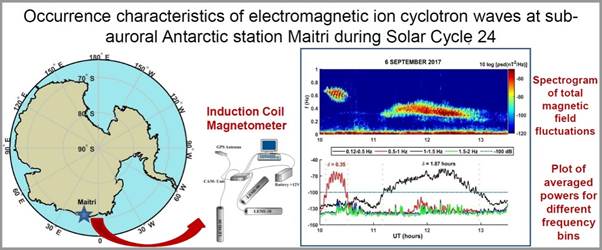ELECTROMAGNETIC ION CYCLOTRON (EMIC)
1. Context
A team of scientists from the Indian Institute of Geomagnetism (IIG), an autonomous institute of DST, analysed data collected between 2011 and 2017 by the Induction Coil Magnetometer data, installed at the Indian Antarctic station Maitr to bring out several aspects of the ground observation of the EMIC waves.

2. About Electromagnetic ion Cyclotron (EMIC)
- Scientists have identified Electromagnetic Ion Cyclotron (EMIC) waves, a form of plasma waves in the Indian Antarctic station, Maitri, and studied its characteristics
- These waves play an important role in precipitation of killer electrons: electrons having speed close to speed of light, which form the radiation belt of planet Earth, which are hazardous to our space-borne technology/instruments
- The study can help understand the impact of energetic particles in the radiation belts on the low orbiting satellites
- These Waves consist of more than 99% of the matter in the visible universe consists of plasma
- Our Sun, solar wind, the interplanetary medium, near-Earth region, magnetosphere and upper part of our atmosphere all consist of plasma the fourth state of matter
- These waves are generated in the equatorial latitudes and propagate along magnetic field lines to their footprint in the High-latitude ionosphere
- Their Signatures can be recorded in both Space and ground-based magnetometers
- These waves are higher during the magnetically disturbed days (51%) as compared to quiet days
- The dependence on EMIC occurrence on Solar flux is evident and they are more frequent during the descending phase of the Solar cycle
- The interesting observational feature is the peak occurrence of EMIC in the noon-dusk sector, which is attributed to the plasma plumes at the time in the Earth's magnetosphere
3. About Magnetosphere
- A magnetosphere is the region around a planet dominated by the planet's magnetic field
- Other planets in our solar system have magnetospheres, but Earth has the strongest one of all the rocky planets: Earth's magnetosphere is a vast, comet-shaped bubble, which has played a crucial role in our planet's habitability
- n astronomy and planetary science, a magnetosphere is a region of space surrounding an astronomical object in which charged particles are affected by that object's magnetic field
- It is created by a celestial body with an active interior dynamo
- The solar wind compresses its sunward side to a distance of only 6 to 10 times the radius of the Earth. A supersonic shock wave is created sunward of Earth called the Bow Shock. Most of the solar wind particles are heated and slowed at the bow shock and detour around the Earth in the Magnetosheath
- The solar wind drags out the night-side magnetosphere to possibly 1000 times Earth's radius; its exact length is not known
- This extension of the magnetosphere is known as the Magnetotail, The outer boundary of Earth's confined geomagnetic field is called the Magnetopause, The Earth's magnetosphere is a highly dynamic structure that responds dramatically to solar variations





